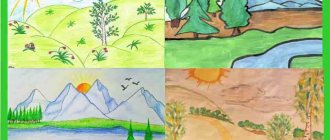Slide captions:
The presentation was prepared by the teacher: Fedotova O.P. MADO TsRR d/s-14. Kropotkin.
You need to bow to the herbs and fall in love with them forever, a stock of medicinal herbs Helps in difficult times.
At Chamomile, at the pharmacy, a dear friend appeared: Lynx treated tonsillitis - The throat no longer hurts.
If something hurts, even the beast cannot resist. What herb should you drink the infusion with? With miracle herb... (St. John's wort)
Along the paths you will meet him, You will heal wounds, abrasions, You will carefully pick off a leaf. Who will heal us? (Plantain)
There are a lot of red lights at the edge of the stumps. Oh, just look: But this is... (Strawberry)
Red beads are hanging, looking at us from the bushes. Children, birds and bears love these beads very much. (Raspberries)
Elk knows - Medicinal burdock will relieve pain like a magician, magically. For gout, I bought a crocodile for future use at the pharmacy.
Oregano blossomed at the sunny edge, and gave her flowers to Alyosha and Valyushka. “Get healthy,” she told them, “Don’t give in to colds, When spring comes.”
Stomatitis and sore throats are treated by foxes and penguins: With wonderful marigolds they relieve tedious pain.
He is a weed, he is a flower, He helped me from illness. As soon as I sit down on the sofa, I will remember yellow... (dandelion)
Birch Schmidt
Schmidt birch (in common parlance - iron birch) - what was planted by nature cannot be cut down with an ax! The prefix “iron” has rightfully taken root with wood because wood is comparable in strength to that of iron. So it will not be possible to cut down such a tree easily. Schmidt's birch doesn't even burn! The wood of this plant sinks in water, it is so heavy.
Iron birch grows in the south of Primorsky Krai, Korea and China. The tree is very rare.
Banyan - "around the world" trip
In fact, to get around this tree-forest you will need to travel a distance of... 330 meters!
In visual terms, this is a cluster of many trees, and not in reality - one single tree! The roots descend from the branches of the tree to the soil and take root in it.
Eucalyptus - will not save you from the heat
The leaves of the plant are located edge-on in relation to the rays of sunlight, so that they do not create a shadow on the ground.
Plus, not a single tree in the world grows as fast as eucalyptus: three meters, and this... in the first year of life. In general, the height of the eucalyptus exceeds one hundred meters.
And, the leaves of the plant do not fall off, but it sheds... bark.
And the birthplace of the tree is Australia.
Rainbow eucalyptus is considered to be the most beautiful tree in the world.
During the renewal of the bark, the plant trunk acquires all the “colors of the rainbow” - a truly magnificent sight!
When you first look at the rainbow eucalyptus, you get a deceptive impression - it seems that it was painted by playful children...
But all this is the work of nature!
Baobab - the thickest “building” of nature
The thickness of the baobab trunk can be even more than 10 m.
But it’s one thing to see this tree in a picture and quite another... in person! One gets the impression that the tree is growing upside down, as if it fell to the ground from the sky.
If the age of an ordinary tree can be determined by the number of rings on the cut of the trunk, then the age of a baobab is quite difficult to determine (the tree has no rings).
Scientists have determined that the lifespan of the plant exceeds... a thousand years!
Habitat: Australia and Africa. You can even... live in a baobab tree!
On the topic: methodological developments, presentations and notes
The presentation is intended for general familiarization of children with medicinal plants of the Krasnodar region (nettle, lilac, bird cherry, linden flowers, coltsfoot, St. John's wort, raspberry, black elderberry, under...
This presentation should be used when introducing medicinal plants to older preschool children. In this case, the proposed visual material in combination with artistic…
Introduce children to medicinal plants, collection rules, storage and their use for medicinal purposes. Introduce children to medicinal plants, collection rules, storage and their use for medicinal purposes. Develop environmental thinking in the process of research activities and creative imagination. Develop environmental thinking in the process of research activities and creative imagination. Expand children's vocabulary and form grammatical structure of speech. Expand children's vocabulary and form grammatical structure of speech. To cultivate a caring attitude towards medicinal plants, the ability to preserve and use them correctly, the desire to recognize them by appearance, description and models. To cultivate a caring attitude towards medicinal plants, the ability to preserve and use them correctly, the desire to recognize them by appearance, description and models
Types of GCD activities, Excursion observations Artistic creativity Familiarization with the rules for collecting and storing medicinal plants Conversations, situational conversation Generalization of ideas about nature Classification of ideas about nature
A lot of medicinal plants grow in our native land; they can be found in the forest, field, meadow, and reservoirs. These are such as: chamomile, oregano, St. John's wort, coltsfoot, burdock, thyme, valerian and many others. Everywhere people, animals, birds can find help from nature. You just need to study them, know them, love them, and be able to use them. A lot of medicinal plants grow in our native land; they can be found in the forest, field, meadow, and reservoirs. These are such as: chamomile, oregano, St. John's wort, coltsfoot, burdock, thyme, valerian and many others. Everywhere people, animals, birds can find help from nature. You just need to study them, know them, love them, and be able to use them. Poor appetite - dandelion root Poor appetite - dandelion root Sick stomach - yarrow, Sick stomach - yarrow, Cold - oregano, chamomile, calendula. Colds – oregano, chamomile, calendula. Wound on hand - nettle, plantain. Wound on hand - nettle, plantain. Sore throat - mother - and - stepmother, chamomile. Sore throat - mother - and - stepmother, chamomile. Leg burn – St. John's wort. Leg burn – St. John's wort. The spots on the body are celandine. The spots on the body are celandine. Every disease has its own medicinal herb, we live in a world of drugs. Every disease has its own medicinal herb, we live in a world of drugs
During direct educational activities during observations and on excursions, the teacher reveals to children the diversity and beauty of the surrounding world, introduces them to the various properties and qualities of medicinal plants, and forms basic concepts about the plant world. A more active assimilation of knowledge is facilitated by the emotional attitude of children to what the teacher is talking about. Experience shows that in older preschool age children without much effort acquire knowledge of the medicinal herbs of our region. An open NOD “Doctor Travkin” was held with them, which was held in an accessible, exciting way, at which the children showed good knowledge about the medicinal plants of our region. GCD consists of three parts. During direct educational activities during observations and on excursions, the teacher reveals to children the diversity and beauty of the surrounding world, introduces them to the various properties and qualities of medicinal plants, and forms basic concepts about the plant world. A more active assimilation of knowledge is facilitated by the emotional attitude of children to what the teacher is talking about. Experience shows that in older preschool age children without much effort acquire knowledge of the medicinal herbs of our region. An open NOD “Doctor Travkin” was held with them, which was held in an accessible, exciting way, at which the children showed good knowledge about the medicinal plants of our region. GCD consists of three parts: Part 1 - conversation (story, excursion, observation, viewing of paintings). Part 1 - conversation (story, excursion, observation, viewing of paintings). Part 2 – environmental game, didactic game. Part 2 – environmental game, didactic game. Part 3 – experimental activities. Observations during a walk were also used, where children became acquainted with medicinal plants. We went on an excursion to the forest with the children. Part 3 – experimental activities. Observations during a walk were also used, where children became acquainted with medicinal plants. We went on an excursion to the forest with our children
Try to collect small bouquets, it is easier to create a beautiful composition from them. Remember well that only the most beautiful, intact, large plants will have healthy offspring. Please leave them to nature. Try to collect small bouquets, it is easier to create a beautiful composition from them. Remember well that only the most beautiful, intact, large plants will have healthy offspring. Please leave them to nature. Be careful with unfamiliar plants. To be safe, it is better not to taste plants unknown to you. Be careful with unfamiliar plants. To be safe, it is better not to taste plants unknown to you. Remember: familiar plants such as St. John's wort and celandine can be poisonous. In the forest you can come across plants that, if handled carelessly, can harm you (scratch, burn) - nettle, rose hips, thistle. Remember: familiar plants such as St. John's wort and celandine can be poisonous. In the forest you can come across plants that, if handled carelessly, can harm you (scratch, burn) - nettle, rose hips, thistle. You need to know that only adults prepare medicinal plants, and children can only help them. You need to know that only adults prepare medicinal plants, and children can only help them. Try to collect small bouquets, it is easier to create a beautiful composition from them. Remember well that only the most beautiful, intact, large plants will have healthy offspring. Please leave them to nature. Try to collect small bouquets, it is easier to create a beautiful composition from them. Remember well that only the most beautiful, intact, large plants will have healthy offspring. Please leave them to nature. Be careful with unfamiliar plants. To be safe, it is better not to taste plants unknown to you. Be careful with unfamiliar plants. To be safe, it is better not to taste plants unknown to you. Remember: familiar plants such as St. John's wort and celandine can be poisonous. In the forest you can come across plants that, if handled carelessly, can harm you (scratch, burn) - nettle, rose hips, thistle. Remember: familiar plants such as St. John's wort and celandine can be poisonous. In the forest you can come across plants that, if handled carelessly, can harm you (scratch, burn) - nettle, rose hips, thistle. You need to know that only adults prepare medicinal plants, and children can only help them. You need to know that only adults prepare medicinal plants, and children can only help them
A child in older preschool age should be able to compare and generalize. In such classes, preschool children’s speech, their thinking, creative abilities, and speech culture are improved. Priority in communication is given to difficult memorization, but to understanding and assessing what is happening. The teacher uses different teaching methods: conversation, story, observation, looking at pictures, uses the necessary methodological literature, reading fiction, didactic games. A child in older preschool age should be able to compare and generalize. In such classes, preschool children’s speech, their thinking, creative abilities, and speech culture are improved. Priority in communication is given to difficult memorization, but to understanding and assessing what is happening. The teacher uses different teaching methods: conversation, story, observation, looking at pictures, uses the necessary methodological literature, reading fiction, didactic games
Native nature is a powerful source from which a person draws his first knowledge and impressions. Children early begin to notice an interest in the living objects around them. A small child looks into the world with wide open eyes and notices everything. Nature attracts the attention of children; as they get acquainted with it, children discover a new world for themselves: they try to touch everything with their hands, smell it, examine it, and, if possible, taste it. It is very important that the adults around the child themselves love nature and try to instill this love in children. The natural world is rich and diverse and our task is to teach children to recognize and be able to use these gifts of nature. One such gift is the medicinal herbs of our region. The best pharmacy is nature. Native nature is a powerful source from which a person draws his first knowledge and impressions. Children early begin to notice an interest in the living objects around them. A small child looks into the world with wide open eyes and notices everything. Nature attracts the attention of children; as they get acquainted with it, children discover a new world for themselves: they try to touch everything with their hands, smell it, examine it, and, if possible, taste it. It is very important that the adults around the child themselves love nature and try to instill this love in children. The natural world is rich and diverse and our task is to teach children to recognize and be able to use these gifts of nature. One such gift is the medicinal herbs of our region. The best pharmacy is nature
The educational value of nature is difficult to overestimate. Communication with nature has a positive effect on a person, makes him kinder, softer, and awakens the best feelings in him. The role of the nature of raising children is especially great. We instill in children a caring attitude towards the nature of their native land from a very early age. In the summer, the children and I plant irises in the plots, and the children learn so many interesting things by observing and caring for them. I try to teach children not only to care for them, but also to show attention and kindness to them. In our preschool institution, on the basis of acquired knowledge, preschool children develop such qualities as a realistic understanding of nature, curiosity, the ability to observe, think logically, and have an aesthetic attitude towards all living things. Nature attracts the attention of children, but the main thing is not observation; the main thing is to instill a caring attitude towards nature from an early age. It is very important that the adults around the child themselves love nature and try to instill this love in children
I must bow over the flowers, not to pick or cut them, but to see their kind faces and show them a kind face. S.Vurgun. Nature has given people an amazing plant world. Trees, herbs, flowers, medicinal plants - they all protect, heal and maintain our health, but we must not forget the rules for handling them.
Flowers and herbs. Flowers and herbs grow in the meadows. They grow in the meadows and take care of our health. They take care of our health. They contain vitamins and medicine too, They contain vitamins and medicine too, From all diseases Herb will help us From all diseases Herb will help us From herbs, flowers - Infusions and decoctions, From herbs, flowers - Infusions and decoctions, Syrups, ointments We value it for good reason . Syrups, ointments We value them for a reason. God's gift Both the grass and the flower! God's gift Both the grass and the flower! God's gift and you appreciate it, my friend! God's gift and you appreciate it, my friend! I worked on the topic “Introducing older preschoolers to the medicinal herbs of our region. When working with children, I often used visual materials, methodological literature, and albums. Conducted conversations, classes, observations, excursions. We went to the forest with the children. We played educational games. Together with the children, we planted a vegetable garden in the window. They planted a vegetable garden on the site. Together with the children, we planted flowers at the discounts. I worked on the topic “Introducing older preschoolers to the medicinal herbs of our region. When working with children, I often used visual materials, methodological literature, and albums. Conducted conversations, classes, observations, excursions. We went to the forest with the children. We played educational games. Together with the children, we planted a vegetable garden in the window. They planted a vegetable garden on the site. Together with the children, we planted flowers at the discounts. I did a lot of work on this topic with my parents. I placed articles, recommendations, and advice about medicinal herbs on stands for parents and in mobile folders. I did a lot of work on this topic with my parents. I placed articles, recommendations, and tips about medicinal herbs on stands for parents and in mobile folders.
Introduction
The relevance of this work is due to the fact that the primary school teacher plays a major role in the development of the child. Lessons from the surrounding world also have a significant role in directly influencing the life of a primary school student.
The teacher must explain and give, in a form understandable to children, primary ideas about the animal and plant world.
When learning new material, the teacher must formulate the topic of the lesson in such a way that the children can understand it and understand it without overloading them with unnecessary material.
The formation of concepts is one of the central tasks of psychology and didactics. To successfully solve the problems of students, the teacher needs to understand them and have an individual approach for everyone.
An important role in the development of a child in primary school is the understanding of subjects and subsequent successful education in primary school.
Subjects in primary school create the basis for mastering all other subjects, at least by teaching children reading, writing and counting. The center of rational knowledge of the world is the system of sciences, the study of which forms the basis of school curricula in primary and high schools. The subject “The world around us”, based on what children have learned in other subjects, accustoms children to a unified understanding of the world around them, prepares them to master the basics of knowledge in high school, and also plays a role in the development and education of the individual.
Object of study: the study of plants and animals in the lessons “The world around us” in elementary school.
Subject of research: developing independence in the study of plants and animals in the “World around us” lessons in elementary school.
The purpose of this work: to characterize the features of the methodology for studying plants and animals in the lessons “The world around us”
Fundamentals of the research: methodological and scientific studies of the theory and methodology of teaching the discipline “The World around us” are discussed in the works of A.A. Vakhrusheva, D.D. Danilova, G.N.Akvileva, N.F.Vinogradova, Z.A.Klepinina, N.M. Verzilina, I.D. Zverev and others.
Information sources
1 Internet resources Textbook technology “House management technologies” 6th grade.
N.V. Sinitsa, V.D. Simonenko MBOU "Ivanovo Secondary School"
Indoor plants in the interior.
The role of indoor plants in human life. Prepared
technology teacher:
Koldorkina
Olga Alexandrovna
- The second option is to place containers on stands around the room. Such decorative stands can be made of wood, forged from metal or woven from wicker. These stands can be moved around the room depending on the mood, light level or season.
- Climbing plants can be used as partitions, and climbing plants can be used as a backdrop for plants with beautiful flowers (for example, fuchsias, gloxinias or Uzumbara violets against ivy).
- The third option is a flowerpot; this option is convenient for decorating small spaces, as a way to enliven the background or decorate a mirror or picture.
- But even the most ordinary clay pot can look absolutely charming if you skillfully highlight it. For example, in a room you can place several identical beautiful flowering plants in such pots, and choose the fabrics used in the interior (tablecloths, curtains, drapes) in the same color scheme or with images of the same flowers. Moreover, clay pots are the most suitable material for flowers.
Design tips
In order for indoor plants to look advantageous in the interior of an apartment, designers give the following recommendations:
1. choose fresh flowers with taste;
2. provide the plants with proper care;
3. For good plant growth, maintain a certain air temperature and humidity in the room, and most importantly, provide natural light.
How to choose a pot?
- A pot is an important element in the life of not only a plant, but also in the interior of an apartment. A beautiful pot can be a decoration for a room. Terracotta containers are considered the most elegant. But a specific interior requires a specific approach. Pots can be made of steel, bronze, wood or outright plastic.
Flowers in the interior
- A large tapeworm plant looks great against the background of light walls. It gets lost against the background of wallpaper with a large pattern or in a cramped small room loaded with furniture. Variegated plants (ficus benjamina, philodendron) benefit from dark walls.
- If you want to “raise” the ceiling and use wallpaper with vertical stripes, then a slender plant will further emphasize this effect. A spreading plant will visually lower the ceiling
The role of plants in our life
- Indoor plants will help you cope with the negative impact of the benefits of modern civilization and benefit your health. Moreover, they can calm you down, relieve fatigue and the effects of stress just by their appearance. It has long been proven that the color green has the unique ability to pacify a person, set him in a positive mood, and “drive” all bad thoughts out of his head.
The benefits of plants.
- Plants that purify the air.
- Plants that fight pathogens.
- Plants that absorb harmful substances.
- Plants that ionize air.
What are some useful plants?
- chlorophytum crested,
- crassula tree,
- asparagus,
- epipremnum pinnate,
- monstera,
- spurge,
- myrtle,
- ruellia,
- Dieffenbachia
Internet resources
- https://www.allwomens.ru
- https://ihouzz.ru
- https://mas-te.ru
- https://yandex.ru
- https://www.u-lekar.ru
To use presentation previews, create a Google account and log in to it: https://accounts.google.com







